TO
| Title | Date | Subject | Description | ||
|---|---|---|---|---|---|
| 1 |
 |
Utah energy: Perspective on unconventional fuels development | 2010-04-28 | Utah energy; oil shale basins; unconventional fuels. | Utah energy goals: 1) Affordable energy 2) Sustainable economy 3) Strengthen energy security and independence 4) Reduce emissions |
| 2 |
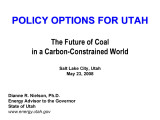 |
Policy options for Utah | 2008-05-23 | energy strategy; Utah energy strategy; energy efficiency; conservation. | UTAH ENERGY STRATEGY: 1-Diversify Energy Portfolio of Renewables and Non-Renewables 2-Improve Energy Efficiency and Conservation 3-Improve Environmental Quality and Reduce Greenhouse Gases 4-Develop Transmission and Transportation 5-Strengthen Energy Security 6-Promote Economic Development 7-Maintai... |
| 3 |
 |
Environmental technologies applicable to shale development: Integrating simulation and experiment | 2008-11-13 | oil shale technologies; oil shale; environmental technologies; shale development | Presentation given at the Utah Oil Shale Resources and Technology Update, November 13, 2008, The Leonardo, Salt Lake City, Utah. |
| 4 |
 |
Millennium synfuels project: Retort process characterization | 2008-03-12 | synefuels; retort process; retort process characterization; energy security; retorting technology; oil shale processing; hybrid energy system; HES | -Energy security issue has led to interest in coal-to-liquids technologies, -One approach use retorting technology commonly associated with oil shale processing, -Hybrid Energy System (HES) technology developed by: Millennium Synfuels, LLC - joint venture of Ambre Energy Pty, Ltd (Australia) and Oil... |
| 5 |
 |
Ending the energy stalemate: A bipartisan strategy to meet America's energy challenges | 2004-12 | Energy; Greenhouse gas emissions; Energy supplies; Energy security; Global climate change; National energy policy; Future U.S. energy policy; Bipartisan; Oil security; Vehicle fuel economy standards; Energy efficiency; Sustainable energy; Hybrid vehicles; Natural gas; Refrigerator; Alaska natural ga... | This report recommends a revenue-neutral package of measures designed to ensure affordable and reliable supplies of energy for the twenty-first century while responding to growing concern about energy security and the risks of global climate change driven by energy-related greenhouse gas emissions. ... |
| 6 |
 |
Unconventional fuel development in the western United States: Integrated assessment of water resources, carbon, and energy impacts and management strategies | 2009 | unconventional fuels; water resources; carbon; energy impacts; fossil fuels; oil shale; CO2 imprint; CO2 capture and sequestration. | The Western United States contains rich fossil resources including abundant supplies of oil shale that could be used to develop substantial quantities of transportation fuel, enhancing energy security in the United States. Development of these resources poses significant questions regarding water re... |
| 7 |
 |
Utah State 1 - Plate 4 | 2014 | oil yeild; Green River Formation; well log; core log | |
| 8 |
 |
Welcome and Introduction: 2009 Western U.S. Oil Sands Conference | 2009-02-27 | oil sands industry; industrial combustion; gasification technology research; CO2 capture technologies; coal; OxyFuel Combustion; chemical looping; gasification; oil shale/sands | Summary of challenges facing U.S. oil sands industry and the role of the Institute for Clean and Secure Energy at the University of Utah in addressing those challenges, presented at the 2009 Western U.S. Oil Sands Conference by Philip Smith, Professor, Department of Chemical Engineering and Director... |
| 9 |
 |
America's oil shale: A roadmap for federal decision making | 2004-12 | Oil shale resources; Oil supply; U.S. economy; Domestic oil shale; Oil production; Multi-agency Federal oil shale plan; Energy; Interior; Defense; Treasury; America; Import dependence; Natural gas by-products; Oil price; Oil supply and demand | The President and the Department of Energy have determined that increasing liquid fuels supply from domestic sources is an important national objective. America's rich and concentrated oil shale resources, containing as much as 2 trillion barrels of potential oil supply could make a major contributi... |
| 10 |
 |
Planning for oil sands development in a changing regulatory, economic, and social environment | 2009-02-27 | oil sands development; oil sands; energy. | Analysis of the regulatory, economic and social issues relevant to oil sands development in Utah, presented at the 2009 Western U.S. Oil Sands Conference by Ron Daniels, Energy Policy Coordinator, Office of Governor's Energy Advisor, State of Utah. |
| 11 |
 |
America's strategic unconventional fuels: Oil shale, tar sands, coal derived liquids, heavy oil, CO2 enhanced recovery and storage | 2007-09 | Colorado; Wyoming; Oil shale development; In-situ; Environmental impacts; Water supply issues; Economics; Socio-ecomonic impacts; Infrastructure; Market challenges; Programmatic Environmental Impact Statement; PEIS; RD&D; BLM; Leasing program; Federal lands; Oil Shale Program Plan; Energy Policy Act | The Task Force members from Colorado and Wyoming have expressed legitimate concerns about the timing and sequence of Federal efforts to promulgate commercial leasing regulations for oil shale development and initiate leasing activity. They are concerned that the current state of development of surfa... |
| 12 |
 |
Strategic significance of America's oil shale resource: Volume 1--assessment of strategic issues | 2004-03 | oil shale; oil shale resource; petrolium production; tar sand; oil shale development. | It is generally agreed that worldwide petroleum supply will eventually reach its productive limit, peak, and begin a long-term decline. What should the United States do to prepare for this event? An objective look at the alternatives points to the Nation's untapped oil shale as a strategically locat... |
| 13 |
 |
Status of the OSEC White River oil shale project | 2010-04-28 | OSEC; shale; status report. | Major milestones in 2008: 1) Formed joint venture with Petrobras and Mitsui 2) Acquired Cliffs Synfuel Corporation 3) Initiated feasibility study |
| 14 |
 |
Oil shale: History, incentives, and policy | 2006-04-13 | oil shale; retorted oil shale yeilds; liquid hydrocarbons | Oil shale is prevalent in the western states of Colorado, Utah, and Wyoming. The resource potential of these shales is estimated to be the equivalent of 1.8 trillion barrels of oil in place. Retorted oil shale yields liquid hydrocarbons in the range of middle-distillate fuels, such as jet and diesel... |
| 15 |
 |
Policy analysis of the Canadian oil sands experience-Topical Report | 2013-09 | Topical Report; Oil & Natural Gas Technology; October 1, 2009-September 30, 2014; Canadian Oil Sands; Policy; Subtask 6.2 | For those who support U.S. oil sands development, the Canadian oil sands industry is often identified as a model the U.S. might emulate, yielding financial and energy security benefits. For opponents of domestic oil sands development, the Canadian oil sands experience illustrates the risks that oppo... |
| 16 |
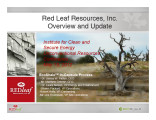 |
Red Leaf Resources, Inc. overview and update | 2012-05-15 | EcoShale; Red Leaf; oil shale; oil extraction | Founded in 2006, Red Leaf Resources, Inc. is a privately-held Delaware corporation based in Salt Lake City, Utah focused on: the production of high-quality oil extracted from oil shale resources, the expansion of its resource portfolio, the licensing of its oil shale extraction technology, the EcoSh... |
| 17 |
 |
Federal control of greenhouse gas emissions | 2010-04-28 | greenhouse gas emissions; federal control efforts; domestic legislation | Federal Control Efforts: 1) International 2) New Domestic Legislation 3) Using Existing Domestic Legislation |
| 18 |
 |
Introduction to Enefit | 2011-05-17 | Enefit; oil shale; mining; power generation; oil shale production | Contents 1.Enefit Overview 2.Enefit280 Process 3.Enefit Outotec Technology JV 4.Enefit Activities in Estonia 5.Enefit American Oil |
| 19 |
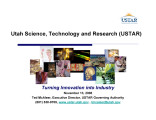 |
Utah Science, Technology, and Research (USTAR): Turning innovations into industry | 2008-11-13 | innovation into industry; fossil energy; USTAR. | Utah Science Technology and Research (USTAR) -- A bold and far-reaching initiative supported by Utah industry and business leaders, sponsored by the Governor and the State legislature, that aims to ensure that Utah remains a leader in the Knowledge Economy! |
| 20 |
 |
Biofuels--snake oil for the twenty-first century | 2008-12-01 | Most Americans are painfully aware that our present consumption of petroleum is unsustainable. The United States has less than 5% of the world's population, but consumes 24.4% of the world's petroleum production. Only 8.5% of the world's petroleum production comes from American wells, which necessit... | |
| 21 |
 |
Climate change regulation via the back door | 2011-05-17 | ||
| 22 |
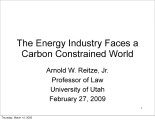 |
The energy industry faces a carbon-constrained world | 2009-02-27 | carbon regulation; energy industry; carbon control; CO2 sequestration; GHG. | Analysis of the impacts of potential frameworks for carbon regulation on the energy industry, presented at the 2009 Western U.S. Oil Sands Conference by Arnold W. Reitze, Jr., Professor, S.J. Quinney College of Law, University of Utah. |
| 23 |
 |
Carbon capture and sequestration: A regulatory gap assessment - Topical report | 2012-04 | carbon capture and sequestration; gap assessment; CCS; climate change | Though a potentially significant climate change mitigation strategy, carbon capture and sequestration (CCS) remains mired in demonstration and development rather than proceeding to full-scale commercialization. Prior studies have suggested numerous reasons for this stagnation. This Report seeks to e... |
| 24 |
 |
CRS report for Congress: Developments in oil shale | 2008-11-17 | Green River; Oil shale formation; Colorado; Utah; Wyoming; Oil; Oil shale; Diesel; Jet fuel; Department of Energy; DOE; Synthetic fuels; Petroleum; Energy Policy Act of 2005; EPAct; BLM; Oil research, development, and demonstration; RD&D; Programmatic Environmental Impact Statement; PEIS; Oil shale ... | The Green River oil shale formation in Colorado, Utah, and Wyoming is estimated to hold the equivalent of 1.38 trillion barrels of oil equivalent in place. The shale is generally acknowledged as a rich potential resource; however, it has not generally proved to be economically recoverable. Thus, it ... |
| 25 |
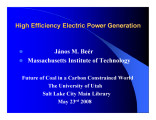 |
High efficiency electrical generation | 2008-05-23 | efficiency of electrical generation; electrical generation; fossil fuel energy resources; mitigatint GHG emissions; CO2 capture and sequestration | Outline: 1-Electricity outlook and fossil fuel energy resources. 2-Technology options for mitigating GHG emissions. 3-CO2 cpature and sequestration. 4-Costs. 5-Concluding remarks. |
